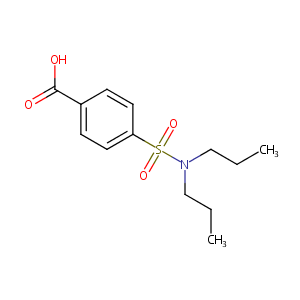Details of the Drug
General Information of Drug (ID: DMMFWOJ)
| Drug Name |
Probenecid
|
||||||||||||||||||||||||||||||
|---|---|---|---|---|---|---|---|---|---|---|---|---|---|---|---|---|---|---|---|---|---|---|---|---|---|---|---|---|---|---|---|
| Synonyms |
Apurina; Bencid; Benecid; Benemid; Benemide; Benuryl; Panuric; Parabenem; Probalan; Probampacin; Probecid; Proben; Probenecida; Probenecide; Probenecidum; Probenemid; Probenicid; Probenid; Probexin; Prolongine; Robenecid; Sulprin; Tubophan; Uricosid; Urocid; Biokanol Brand of Probenecid; ICN Brand of Probenecid; IDIS Brand of Probenecid; Major Brand of Probenecid; Martec Brand of Probenecid; Merck Brand of Probenecid; Ophthalmic Brand of Probenecid; Parmed Brand of Probenecid; Probenecid Major Brand; Probenecid Martec Brand; Probenecid Parmed Brand; Probenecid Weimer; Probenecid Zenith Brand; Probenecid acid; Synergid R; Valdecasas Brand of Probenecid; Zenith Brand of Probenecid; Benemid (TN); Benuryl (TN); Col-BENEMID; ColBenemid (co mponent of); ColBenemid (component of); P-[Dipropylsulfamoyl]benzoic acid; Polycillin-BRB; Pro-Cid; Probenecida [INN-Spanish]; Probenecide [INN-French]; Probenecidum [INN-Latin]; P-(Dipropylsulfamoyl)benzoic acid; P-(Dipropylsulfamyl)benzoic acid; Polycillin-PRB (component of); Probenecid [INN:BAN:JAN]; Probenecid (JP15/USP/INN); 4-((Dipropylamino)sulfonyl)benzoic acid;4-(Di-n-propylsulfamoyl)benzoesaeure; 4-(Dipropylsulfamoyl)benzoic acid; 4-(N,N-Dipropylsulfamoyl)benzoesaeure; 4-[(dipropylamino)sulfonyl]benzoic acid
|
||||||||||||||||||||||||||||||
| Indication |
|
||||||||||||||||||||||||||||||
| Therapeutic Class |
Uricosuric Agents
|
||||||||||||||||||||||||||||||
| Drug Type |
Small molecular drug
|
||||||||||||||||||||||||||||||
| Structure |
 |
||||||||||||||||||||||||||||||
| 3D MOL | 2D MOL | ||||||||||||||||||||||||||||||
| #Ro5 Violations (Lipinski): 0 | Molecular Weight (mw) | 285.36 | |||||||||||||||||||||||||||||
| Logarithm of the Partition Coefficient (xlogp) | 3.2 | ||||||||||||||||||||||||||||||
| Rotatable Bond Count (rotbonds) | 7 | ||||||||||||||||||||||||||||||
| Hydrogen Bond Donor Count (hbonddonor) | 1 | ||||||||||||||||||||||||||||||
| Hydrogen Bond Acceptor Count (hbondacc) | 5 | ||||||||||||||||||||||||||||||
| ADMET Property |
|
||||||||||||||||||||||||||||||
| Chemical Identifiers |
|
||||||||||||||||||||||||||||||
| Cross-matching ID | |||||||||||||||||||||||||||||||
| Combinatorial Drugs (CBD) | Click to Jump to the Detailed CBD Information of This Drug | ||||||||||||||||||||||||||||||
| Repurposed Drugs (RPD) | Click to Jump to the Detailed RPD Information of This Drug | ||||||||||||||||||||||||||||||
Molecular Interaction Atlas of This Drug
 Drug Therapeutic Target (DTT) |
|
|||||||||||||||||||||||||||||||||||||||||||||||||||||||||||||||||||||||
|---|---|---|---|---|---|---|---|---|---|---|---|---|---|---|---|---|---|---|---|---|---|---|---|---|---|---|---|---|---|---|---|---|---|---|---|---|---|---|---|---|---|---|---|---|---|---|---|---|---|---|---|---|---|---|---|---|---|---|---|---|---|---|---|---|---|---|---|---|---|---|---|---|
 Drug Transporter (DTP) |
|
|||||||||||||||||||||||||||||||||||||||||||||||||||||||||||||||||||||||
 Drug-Metabolizing Enzyme (DME) |
|
|||||||||||||||||||||||||||||||||||||||||||||||||||||||||||||||||||||||
 Drug Off-Target (DOT) |
|
|||||||||||||||||||||||||||||||||||||||||||||||||||||||||||||||||||||||
| Molecular Interaction Atlas (MIA) | ||||||||||||||||||||||||||||||||||||||||||||||||||||||||||||||||||||||||
Drug-Drug Interaction (DDI) Information of This Drug
|
Coadministration of a Drug Treating the Disease Different from Probenecid (Comorbidity)
|
||||||||||||||||||||||||||||||||||||||||||||||||||||||||||||||||||||||||||||||||||||||||||||||||||||||||||||||||||||||||||||||||||||||||||||||||||||||||||||||||||||||||||||||||||||||||||||||||||||||||||||||||||||||||||||||||||||||||||||||||||||||||||||||||
Drug Inactive Ingredient(s) (DIG) and Formulation(s) of This Drug
References
| 1 | Probenecid FDA Label | ||||
|---|---|---|---|---|---|
| 2 | URL: http://www.guidetopharmacology.org Nucleic Acids Res. 2015 Oct 12. pii: gkv1037. The IUPHAR/BPS Guide to PHARMACOLOGY in 2016: towards curated quantitative interactions between 1300 protein targets and 6000 ligands. (Ligand id: 4357). | ||||
| 3 | BDDCS applied to over 900 drugs | ||||
| 4 | Critical Evaluation of Human Oral Bioavailability for Pharmaceutical Drugs by Using Various Cheminformatics Approaches | ||||
| 5 | Trend Analysis of a Database of Intravenous Pharmacokinetic Parameters in Humans for 1352 Drug Compounds | ||||
| 6 | Estimating the safe starting dose in phase I clinical trials and no observed effect level based on QSAR modeling of the human maximum recommended daily dose | ||||
| 7 | Transport of organic anions across the basolateral membrane of proximal tubule cells. Rev Physiol Biochem Pharmacol. 2003;146:95-158. | ||||
| 8 | Quercetin, Morin, Luteolin, and Phloretin Are Dietary Flavonoid Inhibitors of Monocarboxylate Transporter 6. Mol Pharm. 2017 Sep 5;14(9):2930-2936. | ||||
| 9 | MRP2 (ABCC2) transports taxanes and confers paclitaxel resistance and both processes are stimulated by probenecid. Int J Cancer. 2005 Sep 20;116(5):824-9. | ||||
| 10 | Characterization of the efflux transport of 17beta-estradiol-D-17beta-glucuronide from the brain across the blood-brain barrier. J Pharmacol Exp Ther. 2001 Jul;298(1):316-22. | ||||
| 11 | Modulation of 3'-azido-3'-deoxythymidine catabolism by probenecid and acetaminophen in freshly isolated rat hepatocytes. Biochem Pharmacol. 1991 Sep 12;42(7):1475-80. | ||||
| 12 | MRP2 (ABCC2) transports taxanes and confers paclitaxel resistance and both processes are stimulated by probenecid. Int J Cancer. 2005 Sep 20;116(5):824-9. doi: 10.1002/ijc.21013. | ||||
| 13 | Evaluation and mechanistic analysis of the cytotoxicity of the acyl glucuronide of nonsteroidal anti-inflammatory drugs. Drug Metab Dispos. 2014 Jan;42(1):1-8. doi: 10.1124/dmd.113.054478. Epub 2013 Oct 8. | ||||
| 14 | Use of immortalized human hepatocytes to predict the magnitude of clinical drug-drug interactions caused by CYP3A4 induction. Drug Metab Dispos. 2006 Oct;34(10):1742-8. | ||||
| 15 | Mercury induces multidrug resistance-associated protein gene through p38 mitogen-activated protein kinase. Toxicol Lett. 2005 Jan 15;155(1):143-50. doi: 10.1016/j.toxlet.2004.09.007. | ||||
| 16 | Targeting organic anion transporter 3 with probenecid as a novel anti-influenza a virus strategy. Antimicrob Agents Chemother. 2013 Jan;57(1):475-83. doi: 10.1128/AAC.01532-12. Epub 2012 Nov 5. | ||||
| 17 | Inhibition of organic anion transporter (OAT) activity by cigarette smoke condensate. Toxicol In Vitro. 2017 Oct;44:27-35. | ||||
| 18 | The human tumour suppressor gene SLC5A8 expresses a Na+-monocarboxylate cotransporter. J Physiol. 2004 Jun 15;557(Pt 3):719-31. doi: 10.1113/jphysiol.2004.063859. Epub 2004 Apr 16. | ||||
| 19 | Neonicotinoid pesticides poorly interact with human drug transporters. J Biochem Mol Toxicol. 2019 Oct;33(10):e22379. doi: 10.1002/jbt.22379. Epub 2019 Jul 31. | ||||
| 20 | Clinical and molecular analysis of patients with renal hypouricemia in Japan-influence of URAT1 gene on urinary urate excretion. J Am Soc Nephrol. 2004 Jan;15(1):164-73. doi: 10.1097/01.asn.0000105320.04395.d0. | ||||
| 21 | Brown G, Zemcov SJ, Clarke AM "Effect of probenecid on cefazolin serum concentrations." J Antimicrob Chemother 31 (1993): 1009-11. [PMID: 8360120] | ||||
| 22 | Abad S, Moachon L, Blanche P, Bavoux F, Sicard D, Salmon-Ceron D "Possible interaction between glicazide, fluconazole and sulfamethoxazole resulting in severe hypoglycaemia." Br J Clin Pharmacol 52 (2001): 456-7. [PMID: 11678792] | ||||
| 23 | Allen MB, Fitzpatrick RW, Barratt A, Cole RB "The use of probenecid to increase the serum amoxycillin levels in patients with bronchiectasis." Respir Med 84 (1990): 143-6. [PMID: 2371437] | ||||
| 24 | Product Information. Doribax (doripenem). Ortho McNeil Pharmaceutical, Raritan, NJ. | ||||
| 25 | DiPiro JT, Welage LS, Levine BA, et al. Single-dose cefmetazole versus multiple dose cefoxitin for prophylaxis in abdominal surgery.?J Antimicrob Chemother. 1989;23 Suppl D:71-77. [PMID: 2722725] | ||||
| 26 | Product Information. Turalio (pexidartinib). Daiichi Sankyo, Inc., Parsippany, NJ. | ||||
| 27 | Sanchez G "Enhancement of heparin effect by probenicid." N Engl J Med 292 (1975): 48. [PMID: 1109193] | ||||
| 28 | Abernethy DR, Greenblatt DJ, Ameer B, Shader RI "Probenecid impairment of acetaminophen and lorazepam clearance: direct inhibition of ether glucuronide formation." J Pharmacol Exp Ther 234 (1985): 345-9. [PMID: 4020675] | ||||
| 29 | Product Information. Caplyta (lumateperone). Intra-Cellular Therapies, Inc., New York, NY. | ||||
| 30 | Product Information. Buphenyl (sodium phenylbutyrate). Horizon Pharma USA Inc, Northbrook, IL. | ||||
| 31 | Goldbart A, Press J, Sofer S, Kapelushnik J "Near fatal acute colchicine intoxication in a child. A case report." Eur J Pediatr 159 (2000): 895-7. [PMID: 11131346] | ||||
| 32 | Cerner Multum, Inc. "UK Summary of Product Characteristics.". | ||||
| 33 | Cerner Multum, Inc. "Australian Product Information.". | ||||
| 34 | Product Information. Ferriprox (deferiprone). ApoPharma USA Inc, Rockville, MD. | ||||
